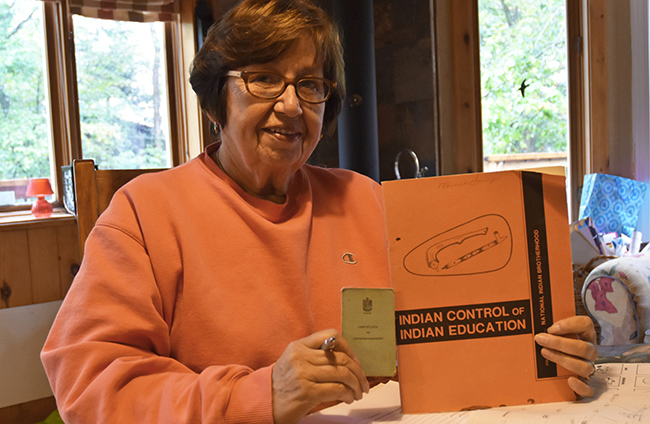Anishinaabe language keeper continues to inspire

By Kelly Anne Smith
NIPISSING FIRST NATION – “Not that long ago I would have had to carry this blue pass. It was my cousin’s mother’s pass. She wants me to share the story.”
Muriel Sawyer holds up the Certificate of Enfranchisement that had to be carried by Anishnaabe Peoples. It was issued by Canada’s Department of Citizenship and Immigration. “I talk about this blue card using it as a teaching tool.”
Muriel Sawyer became a teacher in 1974, always working to revive the language. She retired from teaching at Nbisiing Secondary School in 2005. Now she seems busier than ever.
Sawyer is the Deputy Chief of Nipissing First Nation, and Chair of NFN Education Committee. Also a former board member on the Kinoomaadziwin Education Board that oversees strategy for the Anishinabek Education System (AES). Bill C-61 on the Anishinabek Nation Education Agreement Act received first reading October 5 in the House of Commons.
Sawyer holds up the book, Indian Control of Indian Education which was written in 1972 as a response to the Liberal government’s 1969 White Paper which called to abolish the Indian Act, further assimilating Indigenous peoples. “It’s fulfilling we have control over our own education, and about time.”
Sawyer continues to teach fluent speakers that want to become language teachers. The students study Anishinaabemowin which is also known as the Ojibwe language at college and university level.
Sawyer does not like to be confined to four walls while teaching. She uses the sounds of Lake Nipissing and the surrounding land in her teachings. Sawyer says there is a need to look at different delivery models of education. “You have to go out onto the land, listen to the Elders and utilize their knowledge. Human resources can effect change in our students.”
Professor John S. Long references Sawyer as an Ojibwe language keeper in Treaty No. 9- Making the Agreement to Share the Land in Far Northern Ontario. “The expression mino bimaadiziwin means, literally, “good life.” Sawyer says that bimaadiziwin refers to “our way of life, our laws and teachings, which are fundamentally connected with the land.”
Sawyer researches linguists. “I wanted to look at easier ways to teach the language so the learner would learn more readily, as opposed to learning isolated vocabulary.”
She refuses to call herself an expert, saying she is constantly learning. Sawyer talks proudly of past students that continue to excel on their academic paths. She says Tory Fisher and Blair Beaucage are remarkable for making games and video games for the students to learn the language.
Canada’s Residential Schools outlawed Indigenous languages leaving an immense challenge for Indigenous educators. “If not for the break in our language use, we would be speaking it, we would be teaching in it. We are looking at the AES now. Had there not been a disconnect in our language, of our cultural practices and traditions, we would have immersion programming. We have to make the language part of our community again.”
“Even in our Council meetings I say a giving of thanks. It’s not a prayer. We give thanks. I give it in the language and so does June Commanda. And then every Councillor takes their turn and gives thanks. Slowly it is becoming the way of life, as it should be.”
Muriel gives wise words in Anishinaabemowin. Giishpin go pane Nishnaabemyang, ngoding go mina ka Nishnaabemin which means, “If we speak Ojibway all the time, there will come a time when we will all be able to.”


